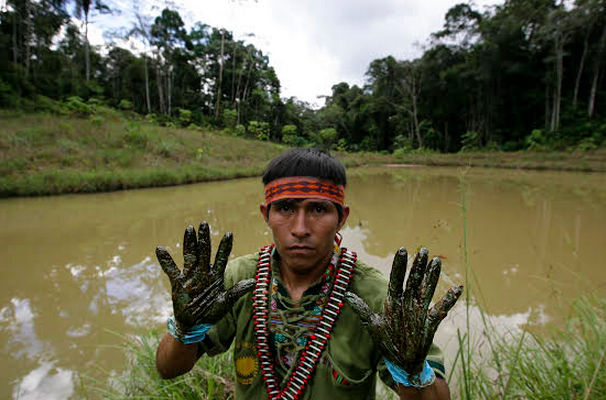
Resident of Jose Olaya village. Photo: Julio Angulo – La Republica.
Gabriela Flores and Milagros Salazar bring you this story that was originally published on Convoca and republished on Global Voices with permission.
Convoca, an investigative reporting outlet in Peru, reviewed more than 20,000 pages of documents about the damage perpetrated by oil companies on the environment and on indigenous people's health. In the first part, Convoca revealed the reports, which had not been made public and had been ignored by the country's last three governments, despite the seriousness of the evidence. In the second part, presented here, Convoca focuses on the companies that benefitted from the omissions.
From the hundred or so companies mentioned in the more than one thousand recorded reports, 54.2% of the reports correspond to only 17 companies. Most of them share commercial interests and are among those most often fined by the Agency for Environmental Assessment and Enforcement (OEFA).
The two operators of the Argentine group Pluspetrol appear among the companies most penalized for environmental infringements between 2007 and 2014, with more than US$22 million in fines. But the 36 instances of imposed fines represent less than a fourth of all the archived reports.
While Pluspetrol Peru Corporation is mentioned in 136 archived reports, its twin company Pluspetrol Norte is a few positions below with 13 reports. The latter company operates at Loreto in lots 8 and 192 (ex 1AB), where indigenous communities have reported the damage to the environment and their health.
Eleven of the 13 reports that were archived between August 2013 and September 2014, correspond to the operations of Pluspetrol Norte in the former lot 1AB. Pluspetrol Norte's contract here expires in August and the company is currently undergoing a process of consultation with indigenous people prior to the renewal of the contract.
Regarding these cases, Pluspetrol said via email that it is “a serious company working in compliance with laws and commitments acquired with the authorities and the State.”
The gas extracted by Pluspetrol from the Peruvian jungle is transferred to the coast by Transportadora de Gas del Peru (TGP), which is the second most fined company, sanctioned for not respecting their own environmental studies. These cases hardly account for 2% of the 107 archived monitoring reports.

Report about a diesel spill from Pluspetrol Norte in lot #8 for which the company was never prosecuted.
In 2005, TGP faced five ruptures of the pipeline that transferred the Camisea gas, the main source of energy in the country. Although the then president Pedro Pablo Kuzcynski defended the company and suggested the possibility of sabotage as a cause of the damage to the pipeline, the Supervising Agency for Investment in Energy and Mining (Organismo Supervisor de la Inversión en Energía y Minería, Osinergmin) did record other environmental incidents.
Due to the permanent Camisea gas leak, on August 29, 2005, the inspectors detected three oil spots the size of a round table on the ground near the pipeline. According to the report, it took three months for the company to remedy the potential environmental impact.
Two months later, another report described the spill of 172 tons of natural gas liquids in the Chunchubamba River in Ayacucho, killing fish on which five local communities depended. The company did not repair the damage, according to other reports between 2006 and 2007.
Among other companies often mentioned in the reports are Grana and Montero Petrolera (GMP), which acquired part of Pluspetrol’s shares in TGP in November 2013. A subsidiary of GMP is Consorcio Terminales, which operates a hydrocarbon storage terminal in Ilo, next to a school with over one thousand students. Since 2001, the authorities of this school have complained about the hydrocarbons leaks and the lack of controls, but until this day the relocation of the terminal has not happened.
Other references to GMP’s activities include possible air pollution for not preventing gas releases in three lots that GMP operates in Piura. But customers of this company also benefited from the violations. One of them was Petrotech Peruana, the company linked to the “petroaudios” case, with eleven official environmental reports.
The signatures
The OEFA’s resolutions that declared the prescription of environmental monitoring reports were signed by its Deputy Director of Investigations Mercedes Aguilar Ramos and his successor Jerry Espinoza Salvatierra after inheriting most of the archived cases in the Osinergmin period. Aguilar signed 23% of the prescriptions in just over 2 years at the Division of Instruction and Research of OEFA while Espinoza was the most productive: he signed 77% of the orders in just nine months in 2014.
Espinoza’s work record is interesting: he worked at the law firm Muñiz, Ramirez, Perez-Taiman & Olaya between July 2008 and April 2013. He left the law firm to become advisor to the Supervision Directorate of OEFA and then became deputy director of Instruction and Research of OEFA where he signed the prescription resolutions of at least two companies that were clients of the law firm where he worked: Interoil Peru S.A. (formerly Mercantile Peru Oil ) and TGP.
The website of Muñiz law firm shows that both companies were advised on disciplinary proceedings and environmental permits. Convoca has asked Espinoza for his version but, at the writing of this article, there has been no answer from him or OEFA.
These hundreds of archived cases are not the only ones. Convoca had access to 62 other archived resolutions in the hydrocarbons, mining and fishing sectors, which were delivered by the Comptroller. This institution declined to give details of the research carried out on officials who allowed the thousands of cases that we reveal today to be prescribed and archived.
When this article was being completed, we received a reply from Osinergmin stating that the documents found by Convoca were not “administrative disciplinary proceedings or reports” and that most of them were “letters, internal management documents” of the entity. However, this is precisely what our investigation has shown: that the formal disciplinary proceedings had never been filed, despite the overwhelming evidence.








